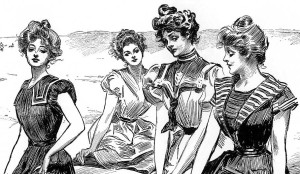In the 1890’s the traits for the ideal woman included piety, purity, submissiveness and domesticity. There was however a real double standard with poor women expected to work and be hardy, but wealthy women were fragile creatures needing to be cared for and protected. It was seen as a character and a sign of not being a ‘true woman’ to have strength. My character, Irena was a poor woman. I think I could relate more to the hard working strong woman. The Gibson Girl was the first ‘model woman’ in had the ideal shape for a woman with a super slender waist – aided by a corset – and rounded breasts and hips.The 1890’s ideas on the ideal woman continue in our culture today, which is perhaps why I struggle with defining my own femininity. I feel like a woman in my own skin, but I really don’t fit cultural expectations.
Here are Gibson Girls hanging on the beach.
Gibson Girls” (engraving after original drawing, titled Picturesque America, Anywhere Along the Coast) in beach attire (cropped image), illustration by Charles Dana Gibson


The thing about “ideal women” is that it changes from culture to culture, and time period as well. Take for example the big movement about “love your curves” in America right now, which encourages women who are frankly an unhealthy weight to love their bodies the way they are. At the same time, I have friends who are considered “too skinny” in New Zealand who find that they are thought of as obese in India. Even hair and skin colours come and go with the fashion of the time.
I suspect the society’s “perfect women” has more to do with money- only the kind of girl who can afford a certain look can fit the style- everything from time to go to the gym, eat a balanced diet, get a tan from beach vacations, and wear the latest fashions. The ideals in history were usually set to a lifestyle the poor couldn’t manage.
That is a good insight. I think you are right that a woman’s image is a way to advertise wealth. In some periods fat was attractive because it was an advertisement that you could afford to eat more than you needed. It was also an advertisement than you had enough extra to carry babies.